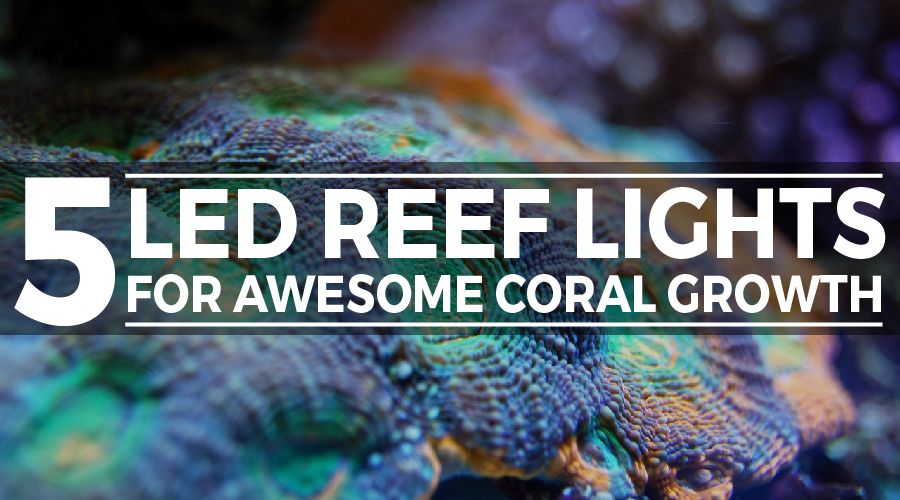One of the most important pieces of any reef tank is the light. Without a quality light, keeping corals is impossible.
That said, picking out a reef tank light can be a daunting task. There are tons of options, types, and sizes available and it’s not always clear which ones are the best.
In this complete review guide, we pick out 5 of the best LED reef lighting fixtures and dive into exactly what makes them great. Use the quick links below for easy navigating.
Best LED Reef Lights: Our Top 5 Picks
Grow coral like a pro with LED reef lights:
Best Overall Pick – Kessil A160WE LED
The Kessil A160WE controllable LED aquarium light is the most pricy LED on our list, produced by a brand that is considered by many one of the best LED reef light sellers. Will those who are willing to splurge a little be rewarded?
This gooseneck LED is available in two varieties: Tuna Sun and Tuna Blue. If you’re reading this you’re probably interested in reef lights, so we’re going to stick to discussing the Tuna Blue, which has a higher light temperature that’s preferable for most reef keepers.
Kessil clearly put a lot of care into designing this LED. The design is simple but sturdy and features a silent fan. Light spectrum and intensity can easily be adjusted both manually and using a controller so you can mimic the natural daylight cycle and keep things as natural as possible. Another great feature is the shimmer this light produces, which also adds to the “natural” feel by imitating the natural effect of sunlight hitting the water. Despite its size this LED produces a pretty good light spread of at least 24”.
So yes: if you’re willing to pay a little extra you probably won’t be disappointed. This light is great for those that prefer a natural look in their tank and the controller programming should be easy to set up despite the various functions.
Pros
- Wonderful shimmer effect that replicates natural sunlight
- Quiet fan
- Not bulky at all; it’s subtle and doesn’t take up as much space as large panels
- Easy to install and program
Cons
- Price
Feature Friendly Pick – AI Prime HD+
The AI Prime HD+ Aquarium LED is a small WIFI controlled LED set for nano reef tanks. A great option if you’re looking for a light that’s not too bulky and will fit small tanks, or if you’re tech savvy and would like to have full control of your light using your smartphone or computer. In fact, this AI Prime light even comes with its own app so you can easily set up and/or program it!
As with the other lights on this list, you can program a lighting cycle to your liking and adjust the color spectrums endlessly to find the perfect settings for your corals. An acclimation setting is included so you can gradually turn up the lighting to prevent shock. The light is bright enough to keep your corals happy and healthy, the fans are silent enough to use in a bedroom or living room and although this is not the absolute best light when it comes to shimmer the reasonable price makes it a great option for your smaller reef tank.
Some users have reported a little bit of difficulty with the initial set-up and programming using the WIFI connection, which is unsurprising given the amount of options. We recommend reading the guidelines closely and maybe looking up some additional instructions if you’re struggling – YouTube is your friend for the installation of any aquarium equipment that might be a little tricky, including LED reef lights.
Pros
- WIFI control using smartphone or computer
- Can be adjusted to your preferences
- Light and not too bulky
- Silent fans
Cons
- Installation and installing can be slightly confusing at first
Best Budget Pick – Current USA Orbit Marine LED
Moving on from the most expensive to the cheapest light on our list, the Current USA Orbit Marine Aquarium LED light is a favorite among reef keepers looking for a light that’s a little more budget proof. Unsurprisingly, this light is very popular – but is that just due to the price, or does it actually outperform more expensive lights?
The Current USA light is a panel LED light that comes with a remote control as well as a small LCD display. It contains dual color spectrums (white and actinic blue) and can be programmed any way you’d like in order to simulate natural lighting changes like sunrise, sunset and moonlight. The gradual change in lighting can help prevent shocking your fish and allows you to see the natural behaviors your fish and corals would normally show in changing light conditions. Additionally, you can “show off” using the additional features such as thunderstorm.
All in all, the Current USA light light definitely performs well for the price and we certainly understand why it’s so popular among marine aquarists. Do keep in mind that it’s not the most powerful on this list at a maximum of 46 Watts for the largest version. If you like to keep your power bill a little lower and don’t mind the fact that this isn’t the ideal choice for growing corals, it can be a good budget option. We do have to note that programming the settings can be a little challenging, especially if you don’t have experience with programming aquarium lights, and as can be expected at this price point this is not the highest quality light on the list. The timer occasionally misbehaves and it has been reported that the feet this light rests on can show signs of rust after a while.
Pros
- Price
- Can be adjusted and/or programmed to any setting you need and includes a remote control
Cons
- Programming can be a little difficult
- Quality is not the absolute highest
- Not the strongest light on the list
VIPARSPECTRA 165W LED
Need brightness? The VIVARSPECTRA Timer Control 165W LED Aquarium Light has it. In fact, this LED reef light is so powerful we recommend being a little careful with it! Don’t look into the light when it’s on and be sure to acclimate your tank nice and slowly, starting at a very small percentage of the total brightness.
This LED panel has two separate lighting channels (blue and white) that can be operated separately brightness-wise using a handy little remote control. It can be suspended from the ceiling and hung above your tank, which comes in handy if you don’t want to have anything attached to your tank. The design is simple with a timer control system that has a little LCD display on the front of the light so you can immediately see if all is well.
If you’re interested in this light, keep in mind that it does not come with as many programmable options as some of the others on this list. You can’t program fading sunrises and sunsets nor is there a moonlight option or any fancy weather imitation settings. There is also no WIFI connectivity that allows you to operate the light using your phone or computer. If you want the absolute most natural thing for your reef or prefer full control using your smartphone then this VIVARSPECTRA LED might not be ideal – otherwise it’s a great choice that can support corals and won’t be too hard on your wallet. And it’s quiet too!
Pros
- Not too expensive
- Extremely bright, perfect for corals
- Simple design with nice silent fans
Cons
- No advanced settings possible
- No WIFI connectivity
- Timers can be slightly off
Fan Favorite – OceanRevive Arctic-T247 Full Spectrum LED
The OceanRevive Arctic-T247 Full Spectrum Dimmable 120W LED is a medium priced LED panel that comes with both retractable brackets and a hanging kit for those who would like to suspend it over their tank. It features a blue as well as a white channel that can be controlled independently using a remote control, has a built-in timer and contains two cooling fans. This is a very bright light, which makes it suitable for growing most corals in smaller reef set-ups.
Like the VIVARSPECTRA LED we discussed previously, the OceanRevive LED lacks the possibility of programming a sunrise/sunset cycle and does not have a moonlight option. It also doesn’t come with a WIFI option, so you’ll have to program it using the built-in timer.
All in all, despite the lack of options this is still a great option for those looking to grow some corals without forking over a large amount of money. The lack of programmable options might make for a slightly less natural feel than some other lights, but the brightness, solid design and coverage definitely make up for this small downside.
Pros
- Has brackets and a hanging kit
- Bright enough to grow corals
- Silent fans
Cons
- Timer can be a little off
- No possibility of programming a natural lighting cycle
Why Are LEDs the Best Choice for Reef Tanks?
When I first started keeping reef tanks, LEDs were not yet popular. Lighting options consisted mostly of Power Compact (PC), T5, and Metal Halide fixtures. All of these options had very clear cons:
- Power Compact: Cheap, but were only capable to sustaining soft corals
- T5: Mid-range in price and could sustain soft easy LPS corals, but needed to be replaced every year
- Metal Halide: Could sustain SPS corals, but were very expensive and put off TONS of heat
When LED reef lights starting breaking into the hobby they really changed the game. LEDs combine all of the best aspects of other types of aquarium lighting while eliminating the bad aspects. Here are a few reasons why LEDs are a no-brainer when it comes to reef tanks:
They are capable of sustaining any type of coral
Before LEDs, your reef lighting choice was largely based on the type of coral you were planning to keep. LEDs, on the other hand, are just as capable of growing tough SPS coral as they are soft coral.
A lot of beginners start out content with easy soft corals, but decide (usually not long later) that they want to venture into some stony options. With an LED light fixture, no lighting change is necessary! In addition, LEDs allow you to keep a nice mixture of different coral types without having to worry if they’re getting enough light.
They don’t put off a lot of heat
PC, T5, and (especially) Metal Halide light fixtures tend to put out a TON of heat. As a result, aquarium coolers (which can be ridiculously expensive) are often necessary to bring the water temperature down to normal levels.
LEDs, on the other hand, put off very little heat compared to other types of light fixtures. This not only lets you skip the cooler, but also helps reduce electricity costs and is less of a fire hazard.
They are compact in size
LED reef lights are generally much smaller than other types of aquarium light fixtures. In fact, some options such as the AI Prime and Kessil A160WE are around the size of a soda can. This not only saves space, but also helps create a much more natural and minimalist look.
They last incredibly long
When I set up my first reef tank with a T5 fixture years ago, one of the biggest hassles of buying new bulbs every 8 months. Not only did I have to special order bulbs online, but they were extremely expensive. Most of the time it was cheaper to replace the entire light fixture than order only the bulbs (weird, huh?).
LED light fixtures, though, last a ridiculously long time. Even on the low end, LEDs don’t need to be replaced until around 50,000 hours. If you’re running your light for 10 hours a day, you won’t have to worry about the bulbs burning out for 13+ years.
Coral Suggestions for Beginners
There are tons of corals that reef owners of any experience level can keep. In general, anything that doesn’t require flawless water condition is the best choice. Luckily for us, most soft corals are pretty forgiving when it comes to water conditions! In the list below, we will cover the five most common species of soft coral and their care requirements; Xenia, Green Star Polyps, Zoanthids, Mushrooms, and Leathers.
1. Xenia
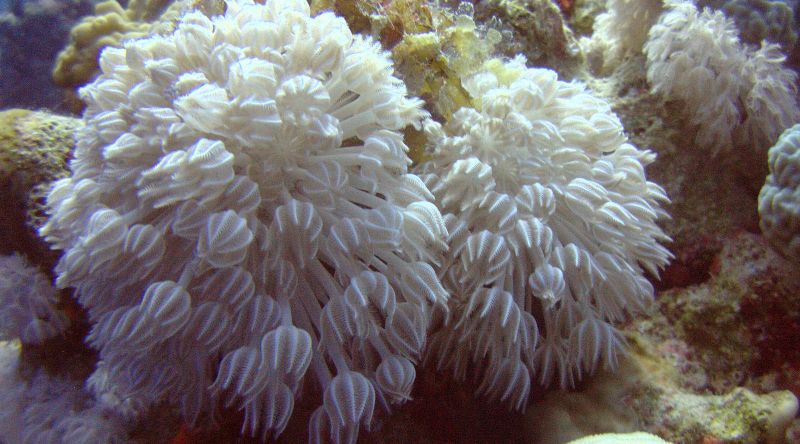
Xenia was the first type of coral that I ever kept, and boy was it fun. Xenia is known for being one of the fastest growing corals available, which is usually extremely satisfying for new reef keepers. Watching something, especially a coral, thrive and grow in your tank is the best feeling ever. For some reef keeper, Xenia’s rapid growth can actually be a little too excessive. It is known to take over tanks and sometimes smother other corals in the process. If you are brand new to reef tank, I wouldn’t worry about this just yet. I never had any problems with Xenia growth being too excessive.
Keeping Xenia is really just a hit or a miss. In some tanks, even dirty and unkept, Xenia thrives. In other tanks it simply melts away. Reefers have been speculating as to why this happens, but no one really have the perfect answer yet. Just know that if Xenia doesn’t “take” in your tank, it doesn’t mean you’re doing anything wrong!
Lighting
Xenia is pretty forgiving when it comes to lighting. I’ve had Xenia thrive with anything from Power Compact to T5s to LEDs. The great thing about Xenia is that you can place them basically anywhere in the tank, as they don’t require extremely high PAR levels like LPS or SPS corals.
If you can splurge for a good LED reef light (like one of the ones we covered earlier), I would highly recommend it. Like I said before, it is not necessary to have LEDs to keep many soft corals, but growth will be much better and you will have the option to venture into LPS and SPS corals in the future without upgrading your lights!
Water Parameters
Keeping a consistant temperate is one of the most important things in reefkeeping. For Xenia, I would recommend keeping your tank at 78-79° F. They tend to like their water on the warmer side, but hate swings in temperature. It is best to just pick a temperate and stick to it.
Salinity is another important factor when it comes to growing Xenia. Much like temperature, it is more important to keep salinity consistant than at a specific spot. I would recommend somewhere between 1.023 to 1.026. Big swings in salinity have been known to cause Xenia to melt away, but it really depend on the specific occasion.
When it comes to water parameters, just remember to keep your temperature and salinity stable. You don’t need to worry about Alkalinity, Calcium dosing, or trace elements. Preventing swings will allow your Xenia to acclimate and thrive. Keeping your parameters stable is a learned skill and may take a while, but thankfully Xenia are pretty resilient!
Water Flow
Where you position your Xenia in the tank relative to the powerheads depends on how you want them to look and grow. One of the most amazing characteristic of Xenia is the “pumping” hands. When placed in direct water flow, this pumping usually stops. If you don’t mind this, I would recommend putting them in a high current area. Growth will be stronger and a big patch of Xenia getting blown around by powerheads looks stunning! Remember, Xenia will grow in the direction of the water flow, so place appropriately!
If you really love the pulsating hands of Xenia (which I do), keep them in a low water flow area. As your Xenia spreads and takes over the rock, the hundreds of pulsating hands will look mesmerizing! Xenia placed in low flow areas also tend to develop thicker stalks.
2. Green Star Polyps (GSP)
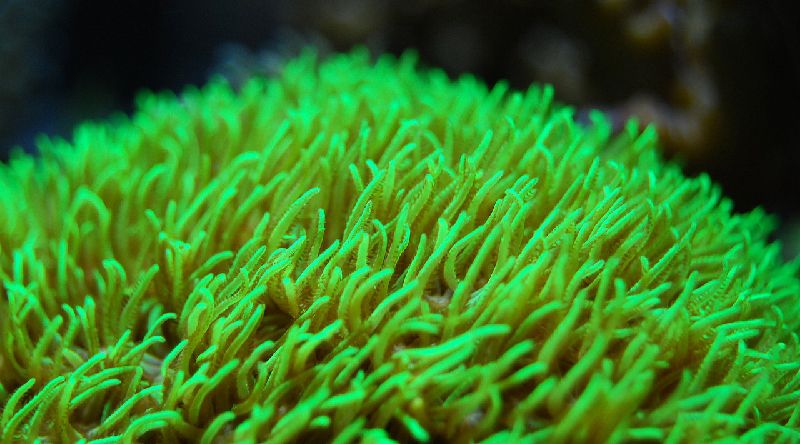
Green Star Polyps are another personal favorite of mine. I love the way that they encrust over rocks and for a stunning green, living carpet. Much like Xenia, the growth of GSP can get out of control and they are known to take over tanks. In addition, they word their way into every crevice of the rocks, so they can be difficult to remove. This part never really scared me, though. I liked the idea of having a GSP dominated tank, which can be very beautiful if done right!
Lighting
Like many other corals on this list, Green Star Polyps really aren’t too picky about lighting. I have kept them under a wide variety of light any they seem to do well under most anything. That being said, I did see significantly more growth once I upgraded to my AI Prime LED fixture. I can’t really blame the GSP, though. Everything seemed to like the LEDs way more.
If you are starting out with an old BioCube or something with power compacts, I wouldn’t worry too much. They can definitely do well under this lighting. Just try to keep them a little higher in the tank and you should notice some good growth!
Water Parameters
Much like Xenia, it is often rumored that Green Star Polyps grow better in water that is a little “dirtier”. This doesn’t mean that you should let your tank go. This simply means that GSP are able go thrive even when tank owners are not always doing the weekly water change.
Water temperature for Green Star Polyps should be kept around 78-79° F. Since they share a good amount of requirements with Xenia, and GSP/Xenia tank may be a good choice for you. The combination of green and pink looks amazing and your reef will look like a flowing forest! As with all corals, put in some extra effort to keeping your temperature stable. Temperate swings often take place at night when the lights go off, so make sure you have a good heater.
Green Star Polyps don’t require anything crazy when it comes to salinity. Like most other corals, they prefer a specific gravity of 1.023 to 1.025. Once again, do your best to keep this stable! Its important to keep the specific gravity stable and do any changes slowly.
Water Flow
There is no debating this fact; Green Star Polyps LOVE strong water flow. I try to place mine in the highest-flow area of the tank. That being said, it is best if this flow is indirect and and the powerhead isn’t pointed directly at the GSP. Having an indirect water flow will make your coral flow in all different directions instead of just getting pounded into one direction 24/7.
Green Star Polyps placed in strong water flow will develop longer polyps and exhibit stronger growth. They tend to encrust rocks in a carpet like formation and bring the rocks to life. In addition, they can also encrust over tank walls, overflow boxes, and pretty much anything else. This can be a great way to grow GSP, as it makes them easy to remove/frag and gives your tank an interesting look.
3. Zoanthids
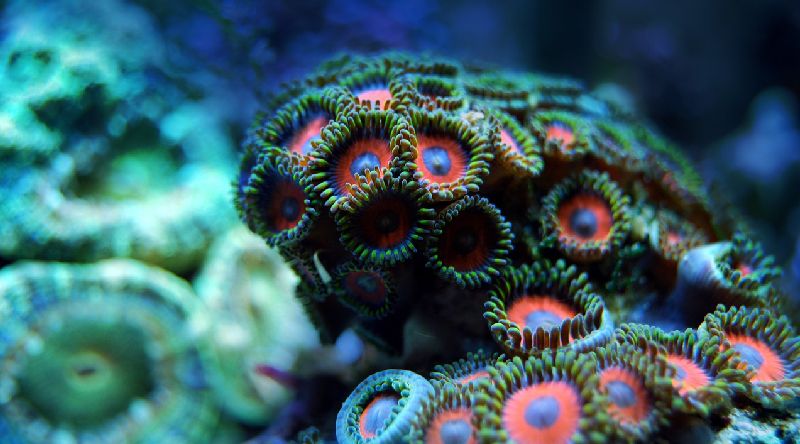
Ahhhh Zoanthids. One of the most popular corals among reefkeepers, Zoanthids come in thousands of shapes and sizes and have inspired some of the most amazing tanks in the world. Zoanthids colonies are made up of a collection of individual polyps, which can vary widely in price. Some frags go for $1 per polyp, while other can go for upwards of $3,000 per polyp! If you are just starting out in the reefkeeping hobby, I would really recommend getting a few cheap species of Zoanthids and watch them grow!
Lighting
If you asked ten different reefers about the best lighting/placement for Zoas, you would probably get ten different answers. Personally, my Zoas love LEDs. LED reef lighting provides a good combination of growth and coloration, which is important for a healthy Zoa colony.
In my opinion, it is more important to find a place in your tank that the Zoanthids are happy then trying to pick the right light fixture. Your Zoas might hate the top and bottom of the tank, but thrive in the middle. Don’t be afraid to move your Zoanthid frag around to find the perfect spot. Once you find a spot that you think it is happy with, leave your frag alone and enjoy the growth! In a tank with good lighting/placement, Zoanthid frags can add new polyps every week. Get a few different strains and let them color up; your reef will come to life in no time.
Water Parameters
You are probably sick of reading this by now, but the most important thing to do when growing Zoanthids is keeping a stable salinity and temperature. Keep your tank at 77-78° F and salinity around 1.023 to 1.025. Many Zoa keepers have noted that they are especially sensitive to high or low specific gravities, so pay a little extra attention to that.
Like many other soft corals, it is often thought that Zoanthids prefer “dirty” water. Though this has never been proven, it is known that Zoanthids feed on particulates in the water column. Keeping a well-stocked tank will ensure that your Zoanthids are being fed. You can also spot feed your Zoas with pellets or frozen foods!
Despite their affinity for slightly “dirty” water (not actually dirty, just dirty in comparison to what SPS corals need), Zoas are especially sensitive to algae or hitchhikers. Since they are an encrusting-type coral, they tend to be covered in algae very easily. If the algae gets too thick, your Zoas can easily be smothered and killed. As a result, do your best to always avoid algae outbreaks and make sure to clean off your Zoas with a turkey baster if things get too bad. In addition, hitchhikers such as hermit crabs and nudibranches can wreak havoc on a Zoanthid colony. If your Zoas seem to close up a lot, take a look to see if anything is disturbing them.
Water Flow
Be careful not to place your Zoanthids in too high of water flow. A medium, indirect flow seems to work best in my experience. Putting your Zoas in direct line of the powerheads will likely cause them to close up and not open.
Test different spots in your tank and see what works best in regard to water flow. You want to have a good turbulence, but just light enough to where they don’t close up. You definitely don’t want any detritus/algae settling on the mat. Like many things with Zoanthids, it is really about finding that sweet spot.
4. Mushroom Corals
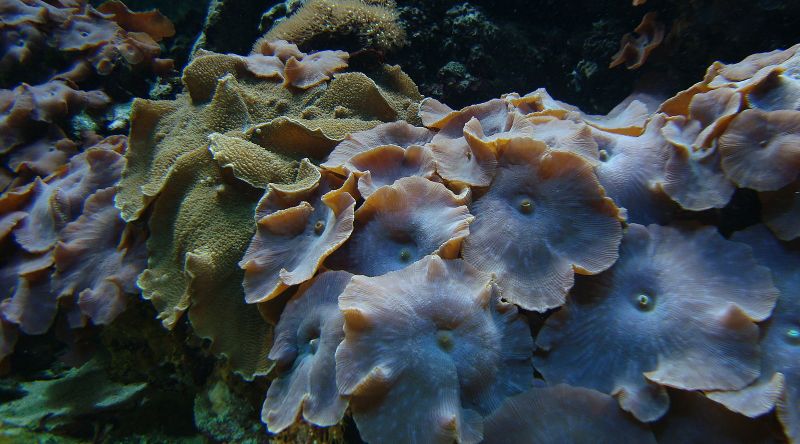
Mushrooms are a go-to coral for any beginner reef keeper. They are tough, grow quickly, and offer great learning experiences. Compared to the rest of the list, mushrooms tend to be the most resilient. They are less likely to melt away for unknown reasons and tend to thrive in most tanks. Like most soft corals, though, they may just not take in your tank, so don’t stress if they don’t do well! Even some experienced reefers simply cant keep them.
Lighting
Mushrooms Corals prefer moderate to low level lights. The tend to do well under any light conditions and can thrive under PCs, T5s, and LEDs. Like always, if you plan to keep others types of coral eventually (which you probably will), I would recommend just biting the bullet and going with an LED reef light.
Luckily, it is pretty easy to tell if your Mushrooms are happy with the current levels of lighting. If the mushroom is not exposed to enough light, it will lose color and form into a “cone” shape as the edges try to reach for more light. If your mushrooms exhibit this behavior, ramp up the lighting ASAP. On the other hand, it is also easy to overpower your mushrooms with light. If your mushrooms stay retracted and lose color, its likely that the lights are too powerful. Try moving the mushroom closer to the bottom of the tank. This is where they tend to thrive anyway!
Mushrooms that are content with the lighting will lay flat and fully bloom. A mushroom that is happy and healthy tends to grow and duplicate very fast. Even if you start with just one, you could possibly have 10+ mushrooms in a matter on months if your tank is healthy. Luckily, they are easy to frag and remove if you want to trade for some other corals!
Water Parameters
Mushrooms can thrive in a wide variety of water conditions. What works for one reef owner may not work the best for another. As with any other coral, its best to try to keep your water parameters stable all the time and avoid large spikes on anything.
Mushrooms tend to like a warmer tank, so try to keep your reef around 78-79° F. This tends to be the average for most soft corals, so you are welcome to keep Xenia, GSP, Zoanthids, and many others in the same tank. A tank full of different soft corals can be beautiful and a great place to start for beginners; I would highly recommend it.
In regard to salinity, mushrooms tens to like their water a little saltier. I have had good success keeping my specific gravity as close to 1.025 as possible. In order to keep track of this easily, I would recommend getting a refractometer. Keeping your salinity in line is too important to be lazy about!
Water Flow
Mushrooms tend to like a low/moderate water flow. Do not point the powerheads directly at mushrooms like you would with other corals such as Xenia or GSP. Mushrooms do best when the flow is indirect and relatively light. That being said, mushrooms love to feed on particulates in the water column, so good water flow is crucial. If you have the time, try to spot feed your mushrooms pellets or frozen food once a week. You will notice a huge increase in growth!
5. Leather Corals
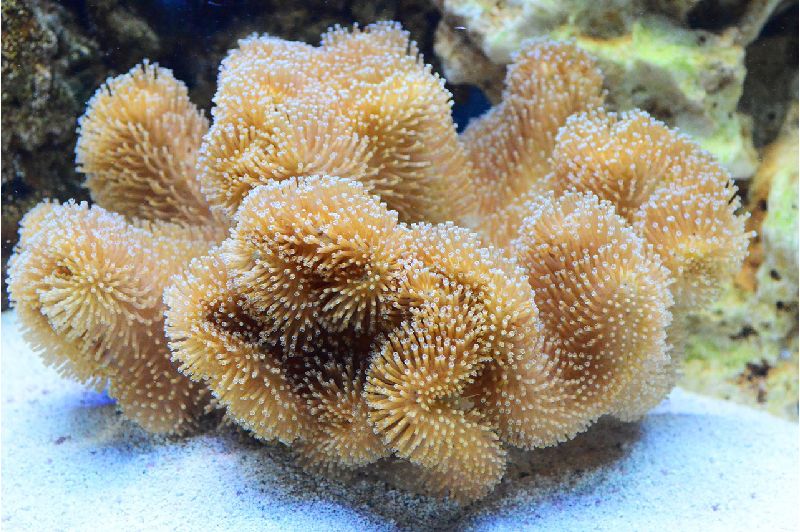
The Leather Coral family is actually made up of a few different kinds of sub-species. These include Cabbage Leathers, Colt Corals, Toadstools, Finger Leathers, and Elephant Ears. My favorite among those is definitely Toadstool Leathers. When they get big, they resemble a large carpet anemone and can be a great centerpiece to any tank. The size of a mature Toadstool is something that many new aquarists don’t often see or have the chance to keep.
Lighting
Leather Toadstools can get pretty large, and thus they require a good amount of light. Though they do benefit from spot feeding, Toadstools get 99% of the nutrients they need from light. If you plan to keep these corals, I would recommend getting a quality LED reef light. A Toadstool with sufficient light should open up completely and show green/yellow polyps. They are known to close up randomly for up to a week, so don’t panic if yours takes a while to get comfortable.
Water Parameters
Toadstools don’t require anything out of the ordinary when it comes to water parameters. They make good tank mates for other soft corals because they require basically the same conditions. Toadstools release toxins, though, that are harmful to SPS corals. If you plan to keep a Toadstool, make it a soft coral or LPS coral tank and leave the SPS behind.
Water temperature should be kept somewhere between 75-78° F, which is pretty standard for any reef. No matter what temperature you pick in that range, just keep it stable and your Leather coral should be more than happy.
Toadstools prefer a specific gravity of 1.023 to 1.025, which puts them in line with most other soft corals. Just try to keep it as stable as possible and you shouldn’t have any problems with your Leather.
Water Flow
Toadstools aren’t as picky about water flow as some other corals on the list. There are reports of Toadstools thriving in low flow to high flow. Personally, I like placing my Toadstools in medium flow because I love the look the their polyps flowing in the current. Medium flow keeps them happy, allows them to feed, and kind of makes them resemble a large carpet anemone! No matter what kind of flow you pick, your Leather Toadstool should thrive as long as you have strong lighting a good water parameters.
Reef Lighting FAQs
Here are a few frequently asked questions regarding LED reef lights:
How many hours per day should I run my lights?
I generally run my lights for 10-12 hours per day – that said, they are only at full power for 8 of those hours. I prefer to do a 2 hour sunrise period in the beginning of the day and a 2 hour sunset at the end.
Remember, coral thrives in an environment that mimics the ocean. A sunrise/sunset period helps keep things as natural and realistic as possible.
How high about the water should I position the light?
This is a question I see all the time – and the answer is, it depends. Personally, I like to position my AI prime 8-10 inches about the water surface. For stronger lights, anywhere from 8-13 inches is a good range.
Keep in mind- the lower you position your light, the tighter the spread. If your corals span the entire tank width, positioning your light close to the surface may not be a great idea. On the flip side, if you group your corals towards the middle of the tank, a tight spread can increase light intensity.
